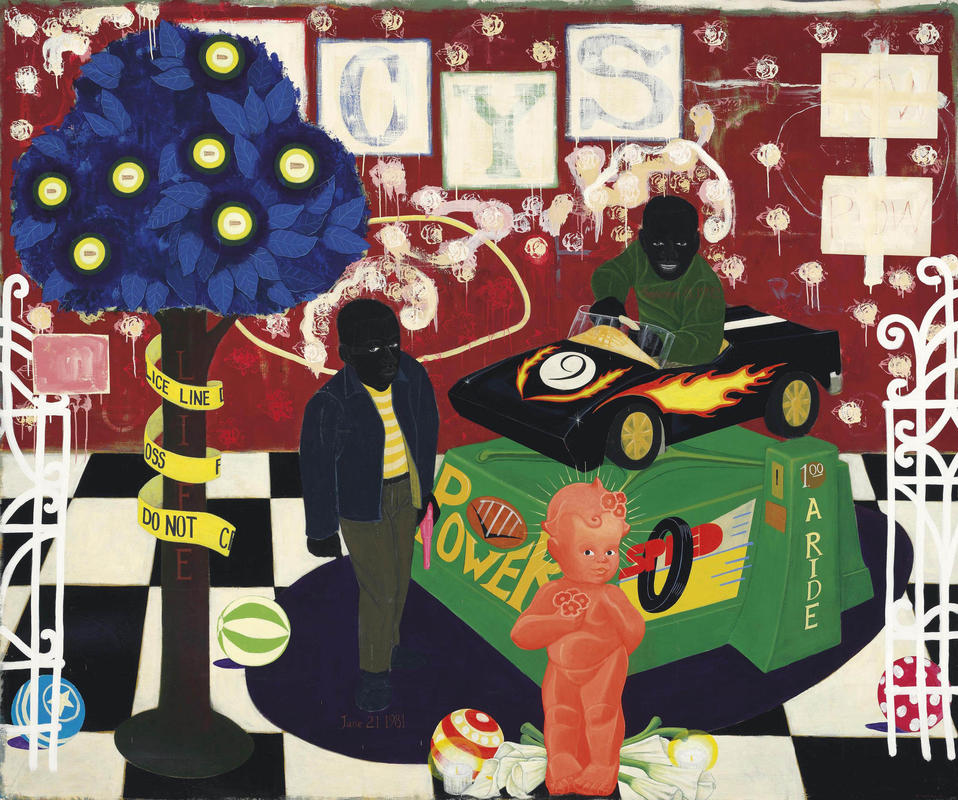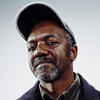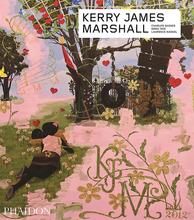More about The Lost Boys
- All
- Info
- Shop

Contributor
Kerry James Marshall’s Lost Boys is a response to the loss of Black youth at the hands of murderous police.
The fact that it was created in 1993 is a sobering reminder that the problems that we face today have been around for a long time. The inspiration for the painting came to Marshall from the death of a boy killed by police when they mistook his toy pistol for a gun. The boy can be seen in the painting with a blank face, a clenched fist, and a pink toy gun. Underneath him is the date of his death. No name is displayed. To the right of him is another boy in a coin-operated car. He smiles, giving the impression that he’s alright. But he’s dead too, the date of his demise on his sweater. The rest of the painting is full of almost abstract representations of the scene that hold a lot of weight. There’s police tape cartoonishly wrapped around a green and blue tree, the branches holding fruit with bullets for seeds, and there are playful children’s alphabet cubes on the wall partially spelling out the word "BOYS."
Marshall has stated that the painting was, in part, autobiographical in nature. A lot of the feelings he was working through were personal as for a number of years he had been dealing with his brother’s incarceration. So it isn’t just about losing lives from the community to shootings, it’s also about the displacement and disruption caused by the prison system, which occurs at a much higher rate for Black people.
The title derives its name from the lost boys from "Peter Pan" who never wanted to grow up, the difference being that those boys had a choice, whereas the ones Marshall is highlighting didn’t. The first thing I thought of with this title was the movie "The Lost Boys," which also derived its name from "Peter Pan." In that movie, the lost boys were vampires who similarly had their lives taken from them, and were forced to inhabit their bodies in the afterlife in the search for blood.
Lost Boys, along with another painting titled De Style, marked a change in Marshall’s career, and the beginning of a lot of his recurring themes and symbolism. It was the first time he’d painted something with such serious subject matter, and on such a large scale (Lost Boys is 8x10 feet). In his own words, he described this work as “seminal” and the kind of works he always imagined himself creating.
Unfortunately, the themes from Lost Boys are still entirely too prevalent today, but Marshall is still out here creating works of art to help us grieve, attempt to rationalize, and remember those we have lost.
Sources
- Tomkins, Calvin. “The Epic Style of Kerry James Marshall.” The New Yorker. August 9, 2021. https://www.newyorker.com/magazine/2021/08/09/the-epic-style-of-kerry-j…
- The Art Story. “Kerry James Marshall Artworks.” Accessed August 17, 2021. https://www.theartstory.org/artist/marshall-kerry-james/artworks/
- Valentine, Victoria L. “‘The Figure Remains Essentially Black in Every Circumstance’: Kerry James Marshall Previews His Master Paintings at MCA Chicago.” Culture Hype. May 2, 2016. https://www.culturetype.com/2016/05/02/the-figure-remains-essentially-b…












